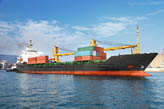Understanding the Differences Between Maritime, Airlift, and快递 Services
When it comes to transporting goods, there are multiple options available to suit different needs and priorities. Among these, maritime, airlift, and快递 (快递) services are the most commonly used. Each service has its own unique characteristics, advantages, and applications, making them suitable for different scenarios. Understanding the differences between these services can help businesses and individuals choose the most appropriate one for their requirements.
Maritime Transport (OM)
Maritime transport, also known as sea freight, is a cost-effective and reliable method for transporting goods over long distances. It is ideal for shipping heavy or oversized items, such as machinery, vehicles, or construction materials. Unlike air transport, maritime transport is not affected by weather conditions, making it a dependable choice for businesses operating in volatile environments. However, it is generally slower than air transport and may incur higher costs for short distances.
Airlift Transport (AIR)
Airlift transport, or air freight, is known for its speed and efficiency, especially for urgent or high-value shipments. It is commonly used for transporting delicate items, medical supplies, or perishables that require preservation during transit. While it offers faster delivery times, air transport can be expensive, particularly for longer distances. It is best suited for businesses with time-sensitive requirements and can handle both fragile and non-fragile goods.
快递 (FE) Service
快递, or express courier services, combines the convenience of air transport with the speed of maritime transport. It is ideal for last-mile delivery and offers a reliable and timely service.快递 services are widely used for shipping small to medium-sized packages, books, electronics, and fashion items. They provide a faster turnaround time compared to traditional mail services, making them popular among individuals and small businesses.
Choosing the Right Service
Selecting the appropriate transport method depends on factors such as delivery time, item fragility, distance, and budget. For example, maritime transport is suitable for long-distance, heavy goods, while air transport is better for urgent, high-value shipments.快递 services offer a balance between speed and reliability, making them a versatile option for most needs.
In conclusion, understanding the differences between maritime, airlift, and快递 services can help you make informed decisions to meet your transportation needs effectively. Whether you prioritize speed, reliability, or cost, there is a transport method that aligns with your requirements. Always consider your specific needs, deadlines, and item characteristics when choosing a transport service to ensure a smooth and efficient logistics process.
